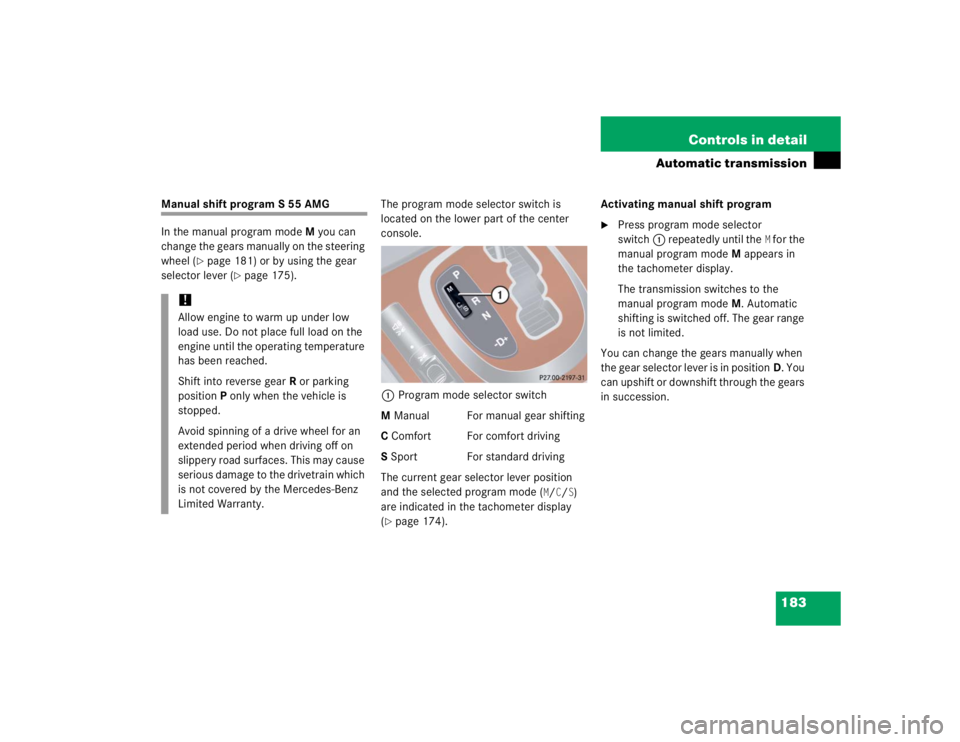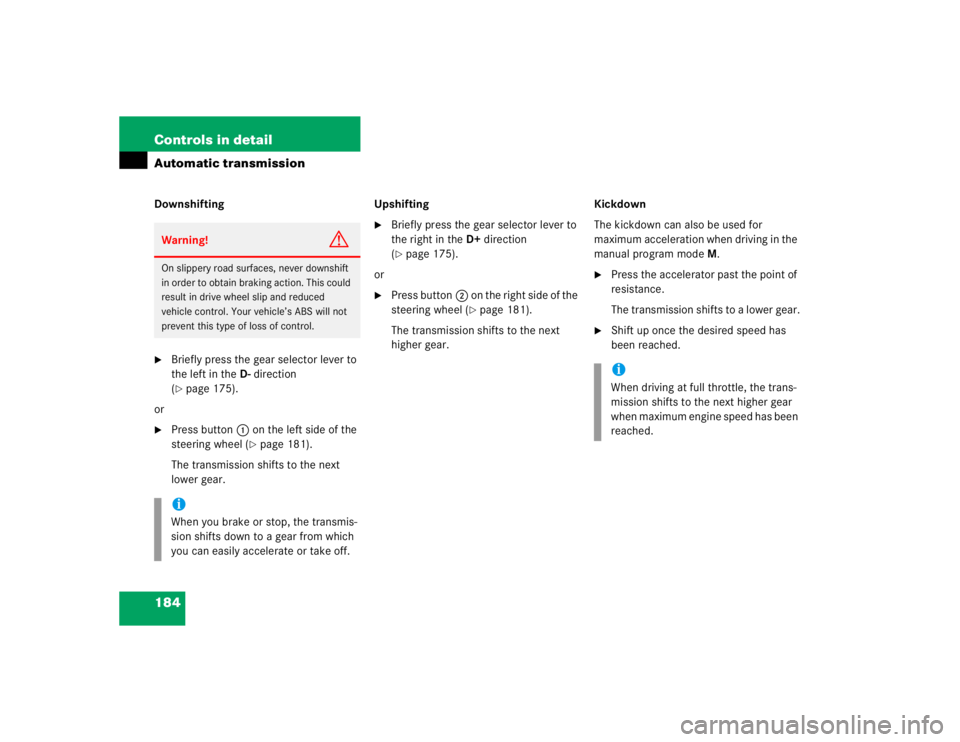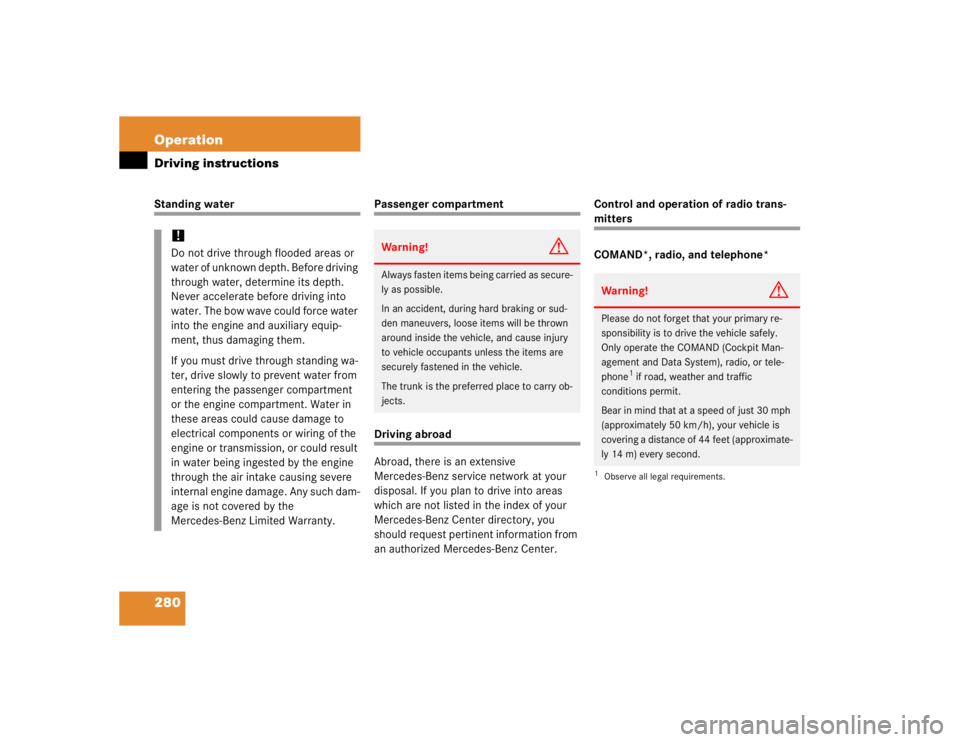Page 185 of 474

183 Controls in detail
Automatic transmission
Manual shift program S 55 AMG
In the manual program modeM you can
change the gears manually on the steering
wheel (
�page 181) or by using the gear
selector lever (
�page 175).The program mode selector switch is
located on the lower part of the center
console.
1Program mode selector switch
M Manual For manual gear shifting
C Comfort For comfort driving
S Sport For standard driving
The current gear selector lever position
and the selected program mode (
M/C/S)
are indicated in the tachometer display
(
�page 174).Activating manual shift program
�
Press program mode selector
switch1 repeatedly until the
M for the
manual program modeM appears in
the tachometer display.
The transmission switches to the
manual program modeM. Automatic
shifting is switched off. The gear range
is not limited.
You can change the gears manually when
the gear selector lever is in positionD. You
can upshift or downshift through the gears
in succession.
!Allow engine to warm up under low
load use. Do not place full load on the
engine until the operating temperature
has been reached.
Shift into reverse gearR or parking
positionP only when the vehicle is
stopped.
Avoid spinning of a drive wheel for an
extended period when driving off on
slippery road surfaces. This may cause
serious damage to the drivetrain which
is not covered by the Mercedes-Benz
Limited Warranty.
Page 186 of 474

184 Controls in detailAutomatic transmissionDownshifting�
Briefly press the gear selector lever to
the left in theD-direction
(�page 175).
or
�
Press button1 on the left side of the
steering wheel (
�page 181).
The transmission shifts to the next
lower gear.Upshifting
�
Briefly press the gear selector lever to
the right in theD+direction
(�page 175).
or
�
Press button2 on the right side of the
steering wheel (
�page 181).
The transmission shifts to the next
higher gear. Kickdown
The kickdown can also be used for
maximum acceleration when driving in the
manual program modeM.
�
Press the accelerator past the point of
resistance.
The transmission shifts to a lower gear.
�
Shift up once the desired speed has
been reached.
Warning!
G
On slippery road surfaces, never downshift
in order to obtain braking action. This could
result in drive wheel slip and reduced
vehicle control. Your vehicle’s ABS will not
prevent this type of loss of control.iWhen you brake or stop, the transmis-
sion shifts down to a gear from which
you can easily accelerate or take off.
iWhen driving at full throttle, the trans-
mission shifts to the next higher gear
when maximum engine speed has been
reached.
Page 187 of 474
185 Controls in detail
Automatic transmission
Deactivating manual shift program�
Press the program mode selector
switch (
�page 183) repeatedly
until
Cor
S appears in the tachometer
display.
or
�
Restart the engine.
The transmission will go to the
automatic program mode (C orS).
The manual program modeM is not
stored.Emergency operation (Limp Home
Mode)
If vehicle acceleration worsens or the
transmission no longer shifts, the trans-
mission is most likely operating in limp
home (emergency operation) mode. In this
mode only second gear and reverse gear
can be activated.�
Stop the vehicle.
�
Move gear selector lever toP.
�
Turn off the engine.
�
Wait at least ten seconds before
restarting.
�
Restart the engine.
�
Move gear selector lever to positionD
(for second gear) orR.
�
Have the transmission checked at an
authorized Mercedes-Benz Center as
soon as possible.
Page 218 of 474

216 Controls in detailDriving systemsSetting a higher speed�
Lift cruise control lever in direction of
arrow1 and hold it up until the de-
sired speed is reached.
�
Release cruise control lever.
The new speed is set.
Setting a lower speed
�
Depress cruise control lever in direc-
tion of arrow2 and hold it down until
the desired speed is reached.
�
Release cruise control lever.
The new speed is set.Fine adjustment in 1 mph
(Canada: 1 km/h) increments
Faster
�
Briefly tip cruise control lever in direc-
tion of arrow1.
Slower
�
Briefly tip cruise control lever in direc-
tion of arrow2.Setting to last stored speed
(“Resume” function)
�
Briefly push cruise control lever in di-
rection of arrow4.
The cruise control resumes the last set
speed.
�
Remove your foot from the accelerator
pedal.
The selected speed appears in the multi-
function display for approximately five sec-
onds, and the corresponding speedometer
segments from the selected speed to the
vehicle maximum speed are illuminated.
iDepressing the accelerator pedal does
not deactivate cruise control. After
brief acceleration (e.g. for passing),
cruise control will resume the last
speed set.
iWhen you use the cruise control lever
to decelerate, the transmission will au-
tomatically downshift if the engine’s
braking power does not brake the vehi-
cle sufficiently.
Warning!
G
The speed stored in memory should only be
set again if prevailing road conditions per-
mit. Possible acceleration or deceleration
differences arising from returning to the pre-
set speed could cause an accident and/or
serious injury to you and others.
Page 225 of 474

223 Controls in detail
Driving systems
Setting a lower speed�
Briefly tip the cruise control lever in di-
rection of arrow2 (
�page 221) to de-
crease vehicle speed in increments of
5 mph (Canada: 10 km/h).
The new speed is set.
The stored speed is displayed in the
multifunction display for approximately
five seconds (
�page 221), and one or
two segments around the stored speed
come on the speedometer
(
�page 219).Fine adjustment in 1 mph
(Canada: 1 km/h) increments
Faster
�
Briefly tip the cruise control lever in di-
rection of arrow4 (
�page 221).Setting to last stored speed (“Resume”
function)
�
Briefly tip the cruise control lever in di-
rection of arrow4 (
�page 221).
Distronic is set to the last stored
speed.
�
Remove your foot from the accelerator
pedal.
iWhen you use the cruise control lever
to decelerate, the transmission will au-
tomatically downshift if the rate of de-
celeration is too low.
Warning!
G
The speed stored in memory should only be
set again if prevailing road conditions per-
mit. Possible acceleration or deceleration
differences arising from returning to preset
speed could cause an accident and/or seri-
ous injury you and others.
Page 270 of 474

268 Controls in detailUseful featuresStep 12:�
Confirm the garage door operation by
pressing the programmed integrated
signal transmitter button (2, 3
or4).
Step 13:
�
To program the remaining two buttons,
repeat the steps above starting with
step 3.Gate operator/Canadian programming
Canadian radio-frequency laws require
transmitter signals to “time-out” (or quit)
after several seconds of transmission
which may not be long enough for the inte-
grated signal transmitter to pick up the sig-
nal during programming. Similar to this
Canadian law, some U.S. gate operators
are designed to “time-out” in the same
manner.
If you live in Canada or if you are having dif-
ficulties programming a gate operator (re-
gardless of where you live) by using the
programming procedures, replace step 4
with the following:Step 4:
�
Continue to press and hold the inte-
grated signal transmitter button (2,
3 or4) while you press and re-press
(“cycle”) your hand-held remote con-
trol transmitter6 every two seconds
until the frequency signal has been
learned. Upon successful training, the
indicator lamp1 will flash slowly and
then rapidly after several seconds.
�
Proceed with programming step 5 and
step 6 to complete.
��
Page 272 of 474
270 Controls in detailUseful featuresInfrared reflecting windshield
1Mounting location for electronic toll
collection devices (infrared transpar-
ent)
2Infrared transparent area
(pass-through for electronic signals)
331.5 in (80 cm)
419.0 in (48 cm)
51.75 in (4.5 cm)Your vehicle is equipped with infrared re-
flecting glass which reduces the amount of
radiated heat entering the interior through
the windows.
The infrared reflecting glass also prevents
the transmission of signals through the
glass by in-vehicle electronic devices (e.g.
electronic toll collection devices).
To allow the use of these devices in the ve-
hicle, two infrared transparent areas
(1and2) are placed in the windshield.
Page 282 of 474

280 OperationDriving instructionsStanding water
Passenger compartmentDriving abroad
Abroad, there is an extensive
Mercedes-Benz service network at your
disposal. If you plan to drive into areas
which are not listed in the index of your
Mercedes-Benz Center directory, you
should request pertinent information from
an authorized Mercedes-Benz Center.Control and operation of radio trans-
mitters
COMAND*, radio, and telephone*
!Do not drive through flooded areas or
water of unknown depth. Before driving
through water, determine its depth.
Never accelerate before driving into
water. The bow wave could force water
into the engine and auxiliary equip-
ment, thus damaging them.
If you must drive through standing wa-
ter, drive slowly to prevent water from
entering the passenger compartment
or the engine compartment. Water in
these areas could cause damage to
electrical components or wiring of the
engine or transmission, or could result
in water being ingested by the engine
through the air intake causing severe
internal engine damage. Any such dam-
age is not covered by the
Mercedes-Benz Limited Warranty.
Warning!
G
Always fasten items being carried as secure-
ly as possible.
In an accident, during hard braking or sud-
den maneuvers, loose items will be thrown
around inside the vehicle, and cause injury
to vehicle occupants unless the items are
securely fastened in the vehicle.
The trunk is the preferred place to carry ob-
jects.
Warning!
G
Please do not forget that your primary re-
sponsibility is to drive the vehicle safely.
Only operate the COMAND (Cockpit Man-
agement and Data System), radio, or tele-
phone
1 if road, weather and traffic
conditions permit.
Bear in mind that at a speed of just 30 mph
(approximately 50 km/h), your vehicle is
covering a distance of 44 feet (approximate-
ly 14 m) every second.
1Observe all legal requirements.